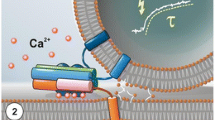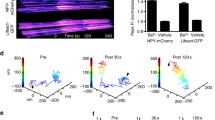Abstract
We have investigated the dynamics of the free [Ca2+] inside the secretory granules of neurosecretory PC12 and INS1 cells using a low-Ca2+-affinity aequorin chimera fused to synaptobrevin-2. The steady-state secretory granule [Ca2+] ([Ca2+]SG] was around 20–40 μM in both cell types, about half the values previously found in chromaffin cells. Inhibition of SERCA-type Ca2+ pumps with thapsigargin largely blocked Ca2+ uptake by the granules in Ca2+-depleted permeabilized cells, and the same effect was obtained when the perfusion medium lacked ATP. Consistently, the SERCA-type Ca2+ pump inhibitor benzohydroquinone induced a rapid release of Ca2+ from the granules both in intact and permeabilized cells, suggesting that the continuous activity of SERCA-type Ca2+ pumps is essential to maintain the steady-state [Ca2+]SG. Both inositol 1,4,5-trisphosphate (InsP3) and caffeine produced a rapid Ca2+ release from the granules, suggesting the presence of InsP3 and ryanodine receptors in the granules. The response to high-K+ depolarization was different in both cell types, a decrease in [Ca2+]SG in PC12 cells and an increase in [Ca2+]SG in INS1 cells. The difference may rely on the heterogeneous response of different vesicle populations in each cell type. Finally, increasing the glucose concentration triggered a decrease in [Ca2+]SG in INS1 cells. In conclusion, our data show that the secretory granules of PC12 and INS1 cells take up Ca2+ through SERCA-type Ca2+ pumps and can release it through InsP3 and ryanodine receptors, supporting the hypothesis that secretory granule Ca2+ may be released during cell stimulation and contribute to secretion.




Similar content being viewed by others
Abbreviations
- BHQ:
-
tert-Butyl benzohydroquinone
- [Ca2+]SG :
-
Secretory granule [Ca2+]
- DMPP:
-
1,1-Dimethyl-4-phenyl-piperazinium iodide
- InsP3 :
-
Inositol 1,4,5-trisphosphate
- SERCA:
-
Sarco endoplasmic reticulum Ca2+ ATPase
- VAMP:
-
Vesicle-associated membrane protein
- VAMP-mutaeq:
-
VAMP-mutated aequorin chimera
References
Allersma MW, Wang L, Axelrod D, Holz RW (2004) Visualization of regulated exocytosis with a granule-membrane probe using total internal reflection microscopy. Mol Biol Cell 15:4658–4668
Alonso MT, Barrero MJ, Michelena P, Carnicero E, Cuchillo I, García AG, García-Sancho J, Montero M, Alvarez J (1999) Ca2+-induced Ca2+ release in chromaffin cells seen from inside the ER with targeted aequorin. J Cell Biol 144:241–254
Alvarez J, Montero M (2002) Measuring [Ca2+] in the endoplasmic reticulum with aequorin. Cell Calcium 32:251–260
Camacho M, Machado JD, Alvarez J, Borges R (2008) Intravesicular calcium release mediates the motion and exocytosis of secretory organelles: a study with adrenal chromaffin cells. J Biol Chem 283:22383–22389
Duman JG, Chen L, Palmer AE, Hille B (2006) Contributions of intracellular compartments to calcium dynamics: implicating an acidic store. Traffic 7:859–872
Endo Y, Harada K, Fujishiro N, Funahashi H, Shioda S, Prestwich GD, Mikoshiba K, Inoue M (2006) Organelles containing inositol trisphosphate receptor type 2 in adrenal medullary cells. J Physiol Sci 56:415–423
Fossier P, Diebler MF, Mothet JP, Israel M, Tauc L, Baux G (1998) Control of the calcium concentration involved in acetylcholine release and its facilitation: an additional role for synaptic vesicles? Neuroscience 85:85–91
Gerasimenko OV, Gerasimenko JV, Belan PV, Petersen OH (1996) Inositol trisphosphate and cyclic ADP-ribose-mediated release of Ca2+ from single isolated pancreatic zymogen granules. Cell 84:473–480
Gerasimenko JV, Sherwood M, Tepikin AV, Petersen OH, Gerasimenko OV (2006) NAADP, cADPR and IP3 all release Ca2+ from the endoplasmic reticulum and an acidic store in the secretory granule area. J Cell Sci 119:226–238
Haigh JR, Parris R, Phillips JH (1989) Free concentrations of sodium, potassium and calcium in chromaffin granules. Biochem J 259:485–491
Haynes CL, Buhler LA, Wightman RM (2006) Vesicular Ca2+-induced secretion promoted by intracellular pH-gradient disruption. Biophys Chem 123:20–24
Huh YH, Yoo JA, Bahk SJ, Yoo SH (2005) Distribution profile of inositol 1,4,5-trisphosphate receptor isoforms in adrenal chromaffin cells. FEBS Lett 579:2597–2603
Hutton JC (1989) The insulin secretory granule. Diabetologia 32:271–281
Iezzi M, Theander S, Janz R, Loze C, Wollheim CB (2005) SV2A and SV2C are not vesicular Ca2+ transporters but control glucose-evoked granule recruitment. J Cell Sci 118:5647–5660
López-Font I, Torregrosa-Hetland CJ, Villanueva J, Gutiérrez LM (2010) t-SNARE cluster organization and dynamics in chromaffin cells. J Neurochem. doi:10.1111/j.1471-4159.2010.06872.x
Mahapatra NR, Mahata M, Hazra PP, McDonough PM, O’Connor DT, Mahata SK (2004) A dynamic pool of calcium in catecholamine storage vesicles: exploration in living cells by a novel vesicle-targeted chromogranin A/aequorin chimeric photoprotein. J Biol Chem 279:51107–51121
Mitchell KJ, Pinton P, Varadi A, Tacchetti C, Ainscow EK, Pozzan T, Rizzuto R, Rutter GA (2001) Dense core secretory vesicles revealed as a dynamic Ca2+ store in neuroendocrine cells with a vesicle-associated membrane protein aequorin chimaera. J Cell Biol 155:41–51
Mitchell KJ, Lai FA, Rutter GA (2003) Ryanodine receptor type I and nicotinic acid adenine dinucleotide phosphate receptors mediate Ca2+ release from insulin-containing vesicles in living pancreatic beta-cells (MIN6). J Biol Chem 278:11057–11064
Montero M, Alonso MT, Carnicero E, Cuchillo-Ibáñez I, Albillos A, García AG, García-Sancho J, Alvarez J (2000) Chromaffin-cell stimulation triggers fast millimolar mitochondrial Ca2+ transients that modulate secretion. Nat Cell Biol 2:57–61
Moreno A, Lobatón CD, SantoDomingo J, Vay L, Hernández-SanMiguel E, Rizzuto R, Montero M, Alvarez J (2005) Calcium dynamics in catecholamine-containing secretory vesicles. Cell Calcium 37:555–564
Mundorf ML, Troyer KP, Hochstetler SE, Near JA, Wightman RM (2000) Vesicular Ca2+ participates in the catalysis of exocytosis. J Biol Chem 275:9136–9142
Nguyen T, Chin WC, Verdugo P (1998) Role of Ca2+/K+ ion exchange in intracellular storage and release of Ca2+. Nature 395:908–912
Pouli AE, Emmanouilidou E, Zhao C, Wasmeier C, Hutton JC, Rutter GA (1998) Secretory-granule dynamics visualized in vivo with a phogrin-green fluorescent protein chimaera. Biochem J 333:193–199
Quesada I, Chin WC, Steed J, Campos-Bedolla P, Verdugo P (2001) Mouse mast cell secretory granules can function as intracellular ionic oscillators. Biophys J 80:2133–2139
Quesada I, Chin WC, Verdugo P (2003) ATP-independent luminal oscillations and release of Ca2+ and H+ from mast cell secretory granules: implications for signal transduction. Biophys J 85:963–970
Santodomingo J, Vay L, Camacho M, Hernández-Sanmiguel E, Fonteriz RI, Lobatón CD, Montero M, Moreno A, Alvarez J (2008) Calcium dynamics in bovine adrenal medulla chromaffin cell secretory granules. Eur J Neurosci 28:1265–1274
Scheenen WJ, Wollheim CB, Pozzan T, Fasolato C (1998) Ca2+ depletion from granules inhibits exocytosis. A study with insulin-secreting cells. J Biol Chem 273:19002–19008
Winkler H, Westhead E (1980) The molecular organization of adrenal chromaffin granules. Neuroscience 5:1803–1823
Wu MM, Grabe M, Adams S, Tsien RY, Moore HP, Machen TE (2001) Mechanisms of pH regulation in the regulated secretory pathway. J Biol Chem 276:33027–33035
Xie L, Zhang M, Zhou W, Wu Z, Ding J, Chen L, Xu T (2006) Extracellular ATP stimulates exocytosis via localized Ca release from acidic stores in rat pancreatic beta cells. Traffic 7:429–439
Yoo SH (2010) Secretory granules in inositol 1,4,5-trisphosphate-dependent Ca2+ signalling in the cytoplasm of neuroendocrine cells. FASEB J 24:653–664
Yoo SH, Albanesi JP (1990) Inositol 1,4,5-trisphosphate-triggered Ca2 + release from bovine adrenal medullary secretory vesicles. J Biol Chem 265:13446–13448
Acknowledgments
This work was supported by grants from Ministerio de Educación y Ciencia (BFU2008-01871) and from Junta de Castilla y León (VA103A08 and GR105). J.S. had a FPI (Formación de Personal Investigador) fellowship from the Spanish Ministerio de Educación y Ciencia (MEC).
Author information
Authors and Affiliations
Corresponding author
Additional information
A commentary to this article can be found at doi:10.1007/s10571-010-9611-z.
Rights and permissions
About this article
Cite this article
SantoDomingo, J., Fonteriz, R.I., Lobatón, C.D. et al. Ca2+ Dynamics in the Secretory Vesicles of Neurosecretory PC12 and INS1 Cells. Cell Mol Neurobiol 30, 1267–1274 (2010). https://doi.org/10.1007/s10571-010-9572-2
Received:
Accepted:
Published:
Issue Date:
DOI: https://doi.org/10.1007/s10571-010-9572-2




